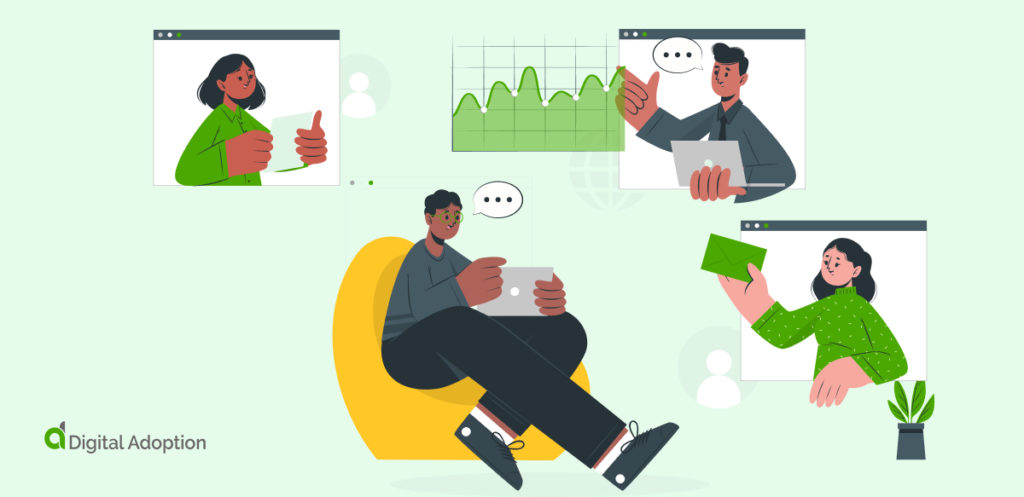Digital engagement, Salesforce, and DAPs go hand-in-hand – as we’ll see in this article, using DAPs to train sales staff is a sure way to improve engagement, productivity, and performance.
Before we explain how, though, let’s briefly explain DAPs.
What is a DAP solution?
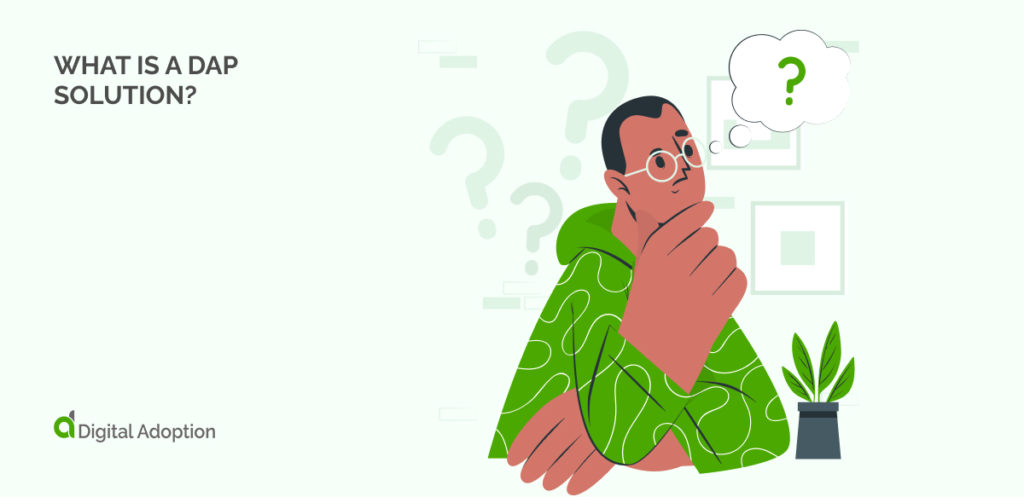
DAP is short for Digital Adoption Platform. A digital adoption solution is software that lies on the interface of another application to guide the end-users in using the application’s features. Such in-app training is practical when onboarding users on complex applications like Salesforce.
An adoption platform for Salesforce simplifies the user experience using in-app messages that prompt the users whenever stuck, walkthroughs that guide users through critical tasks, and more enablement resources. They’re more like intuitive self-service support agents that teach users how to make the most of the application. And once the users know how to use Salesforce to its fullest capacity, an organization achieves user adoption.
Digital adoption tools facilitate change management in digital transformation so that the organization can achieve the business outcomes that prompted the shift. In the context of Salesforce, a DAP provides interactive guides, pop-up messages, nudges, and on-demand support within Salesforce. So your sales team won’t have to research how to complete tasks or raise support tickets for mundane processes.
These adoption tools help businesses with:
- Simplifying employee training and reducing training costs
- Product onboarding
- Product adoption and digital adoption
They are built around several key features that can significantly enhance engagement and improve the user experience.
Typical DAP features
- Contextualized guidance. The software provides interactive assistance directly inside the app. Powered by AI, users can learn exactly what they need to know–precisely when they need to know it. Self-guided learning is incomparable to a situation where users must cram processes from a live training session. The DAPs improve knowledge retention and boost employee productivity.
- In-app walkthroughs. Step-by-step walkthroughs help users learn workflows quickly and easily without human trainers. This increases the pace of learning, keeps users productive, and reduces the need for individual research. It also reduces the number of support tickets during a transformation.
- Software analytics. Analytic reports offer deep insights into how employees use their software. Product teams can pinpoint stumbling blocks, reduce error rates, and implement corrective action.
The best digital adoption platform allows customization when creating the training materials, plus the ability to send out custom surveys to gauge the user experience. Certain platforms, like WalkMe, include modules dedicated explicitly to Salesforce. That’s why PWC used the DAP to onboard 100,000 live users on Salesforce.
According to PWC’s national leader of Digital Services Consulting, Philip Grosch, “WalkMe helped our people navigate through tasks using pop-up messages, nudges, and on-demand support right in the app when needed. We also created “custom “Walk-Thrus” to guide users step-by-step through processes and tasks, letting our people learn in the moment and become more productive.”
He outlines the main benefits of using a DAP solution as:
- zero-time in context and practical training
- ability to segment training content to specific roles
- ability to collect data about how the sales teams used the platform
- automating some tasks to reduce errors and increase productivity
Therefore, WalkMe DAP for Salesforce or Salesforce Lightning is an ideal way to onboard global sales teams.
However, this point brings up an interesting question and an important point.
What is the difference between training and adoption?
A Key Difference: Salesforce Training vs. Salesforce Adoption
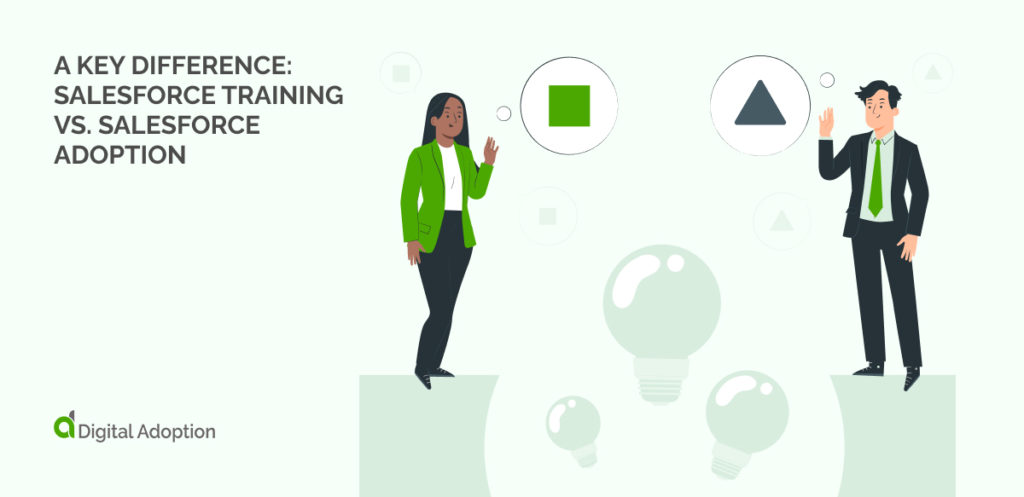
Employee training tends to focus on skills, tools, and abilities. How will the business users log in and complete the sales process on the platform? How will new employees get up to speed with the technology?
Adoption, however, includes training, but it also expands its scope to include:
- Employee productivity, workforce performance, and organizational performance. Training efforts that focus only on employee skills can become too short-sighted. It is easy to lose track of the real aim behind training efforts: organizational performance gains. Therefore, it is best to use a digital adoption strategy and framework. It shows employee engagement with Salesforce (through product analytics), pointing out improvement areas that will optimize workforce performance.
- Streamlining the digital workplace and integrating digital workflows. Gartner reveals that the digital workplace is continually evolving. To keep up, employees must constantly reskill and upskill. Training programs, therefore, must be adaptable and stay focused on making the digital workplace as efficient as possible. Salesforce adoption platforms help the employees catch up with the new workflows and integrate the new processes with other digital processes to provide a consistent customer experience.
- Improving the adoption experience. Onboarding, training, and adoption are all part of the employee experience. Improving that experience will improve engagement, decrease frustration, and help today’s organizations better results from their Salesforce training efforts. Salesforce adoption simplifies employee onboarding and the overall experience through self-guided on-demand learning, in-app messages to prompt the user whenever stuck, and walkthroughs to help them accomplish tasks on the platform.
Experienced digital training managers know that their training efforts inevitably include points such as the above.
There are several reasons why:
- Organizational performance depends on having a workforce that is digitally skilled and productive
- To be productive in today’s digital work environment, employees must be proficient in multiple tools
- Employee engagement, performance, and productivity depend a great deal on their digital experience
In short, company trainers must go several steps beyond “teaching software skills.”
They must focus on the bigger picture: fully adopting and integrating Salesforce into the workplace.
Challenges to Salesforce Training and Adoption
Several challenges can hinder enterprise software training efforts:
Complexity – SaaS platforms such as Salesforce come with steep learning curves. Employees must spend a certain amount of time learning to navigate software to become productive.
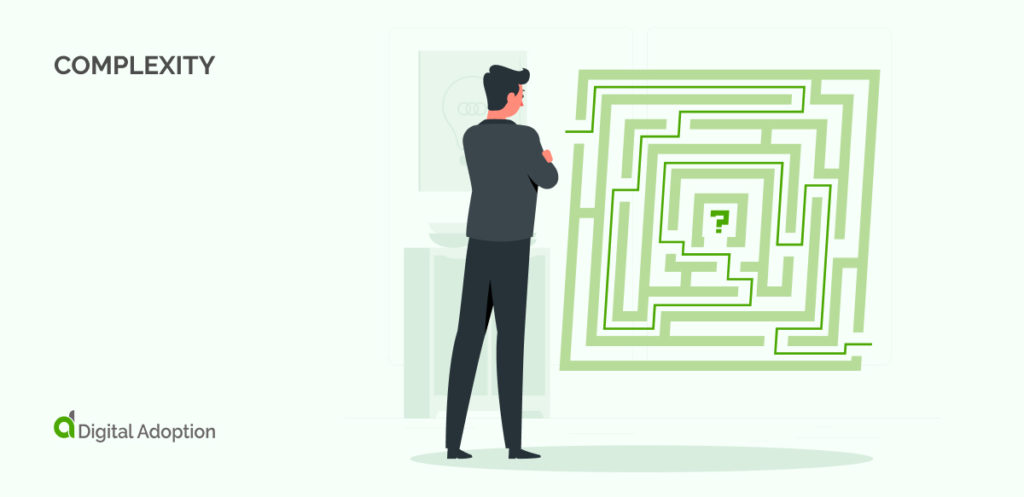
Time – That learning curve means that companies must fund employee training efforts, even if they are not yet productive workforce members.
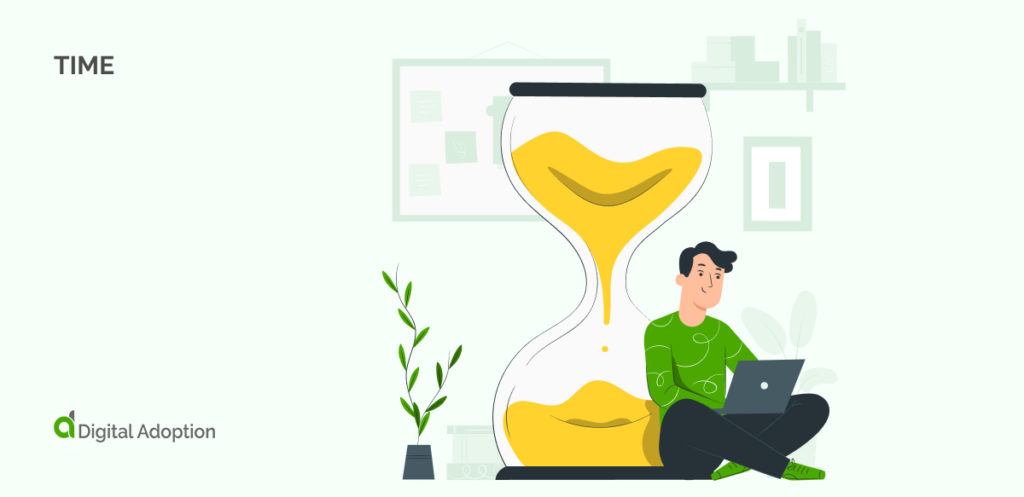
Budgets – As a workforce increases, so do its training needs. This is a natural consequence of increased training needs, complexity, and budget sizes.
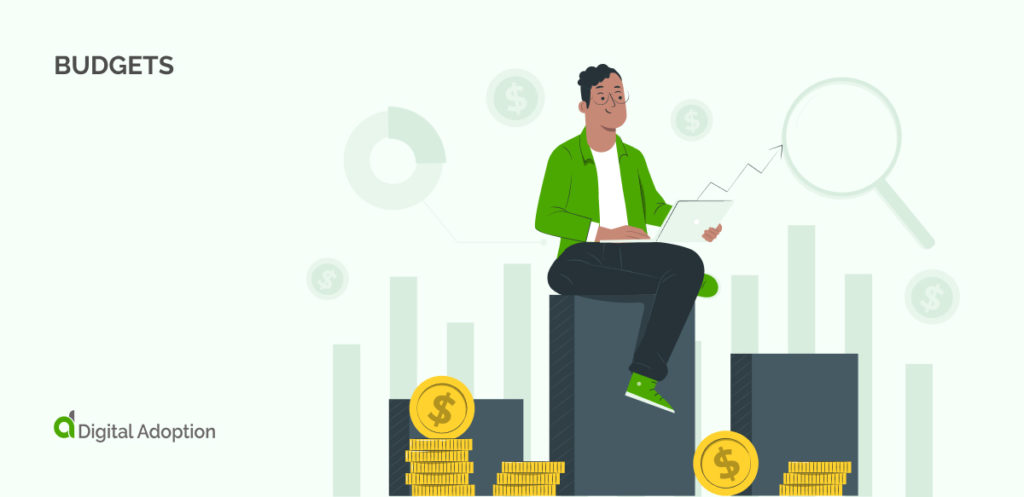
Scalability – Not all training can be scaled efficiently. Human-led training efforts, either in person or online, cannot be scaled cost-effectively, for example.
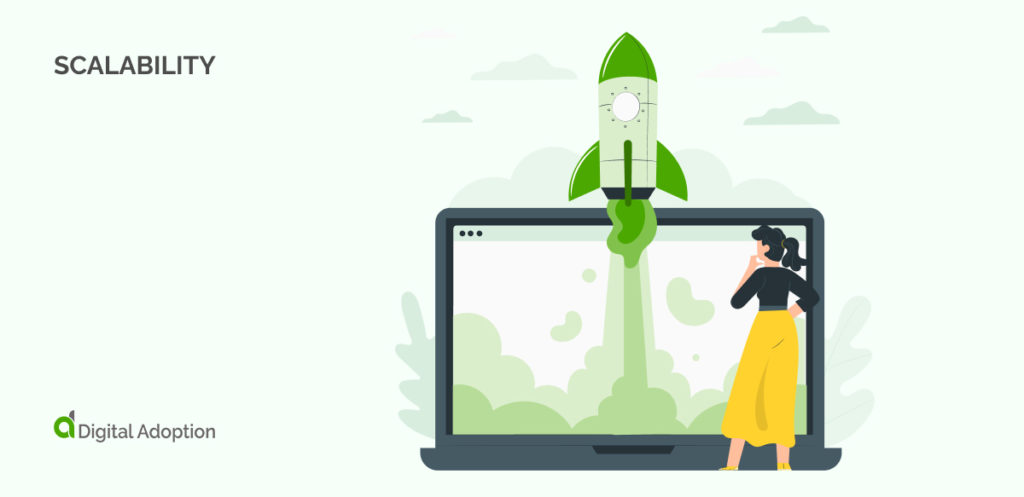
Overcoming these challenges is critical for any training program to be effective. Fortunately for organizations implementing Salesforce, DAPs are designed to overcome these challenges.
Digital Engagement, Salesforce, and Digital Adoption Platforms
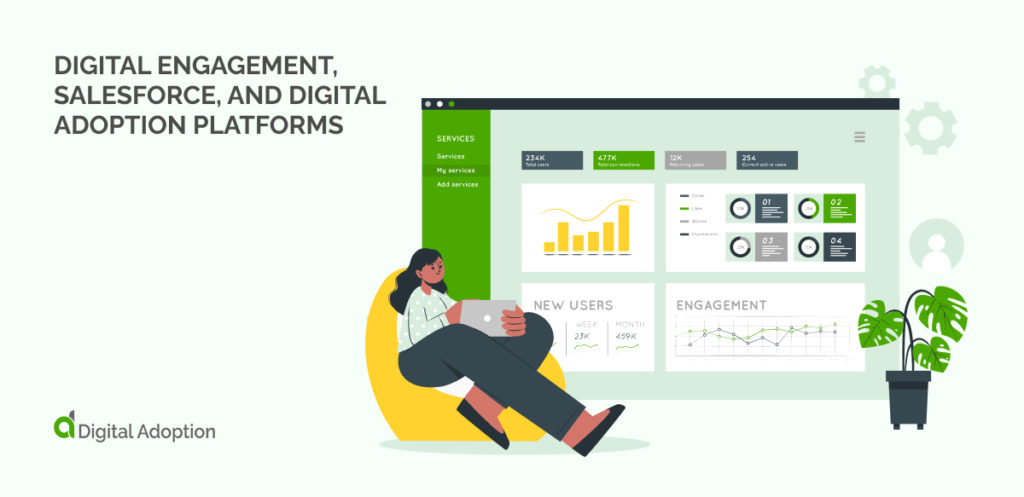
As mentioned earlier, DAPs are platforms that offer in-app guidance, context-based training, interactive product tours, and in-product walkthroughs. They are built specifically for businesses that want to maximize the efficiency of their software adoption efforts.
Organizations can customize digital adoption platforms to their specific needs. For example, creating custom guides for different tasks based on roles. And through machine learning and AI, DAPs provide real-time guidance based on each user’s needs.
Why Use DAPs Over Other Training Solutions?
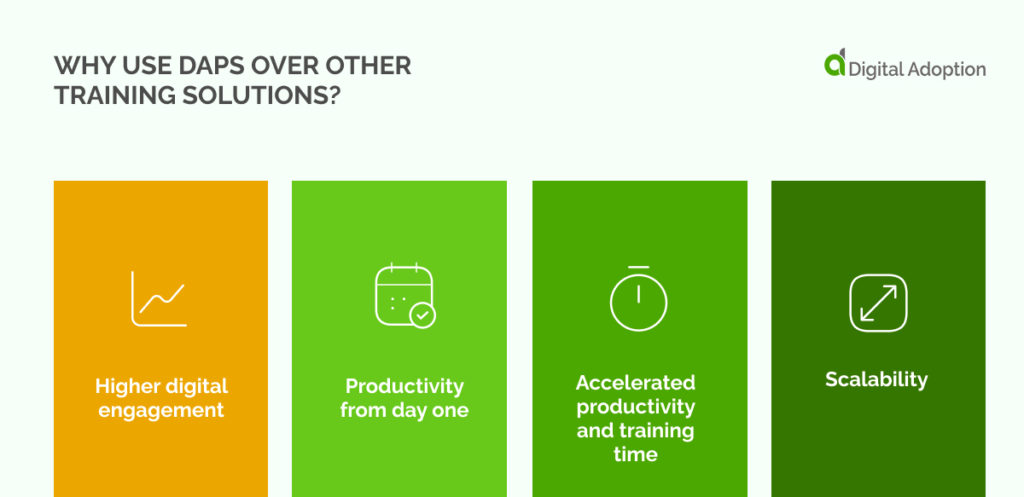
There are several advantages that DAPs offer over other training approaches:
Higher digital engagement
As we have seen, DAPs deliver in-app, interactive, and immediate training. This immediacy helps keep users engaged, dramatically boosting their learning potential and the outcomes of training efforts. The self-help training format that DAPs offer also empowers employees to explore Salesforce, uncovering more ways to use the platform without feeling its complexity.
Productivity from day one
When users can be walked step-by-step through a series of tasks, they can begin performing that task immediately. This is especially important for Salesforce, which can be daunting for new users.
Accelerated productivity and training time
DAPs decrease time-to-competency, helping organizations realize the value of their software more quickly. Employees spend less time learning how to use the software and more time using the software to complete business processes.
In addition, insights on Salesforce engagement show the sales operation teams where the users are struggling so they can fix errors quickly, reducing downtime. The robust analytics reports also help businesses ensure effective internal governance and create measures that support best practices. This increases employee productivity tenfold, which means better experiences for customers and business growth.
Scalability
Scale matters little for organizations that use digital adoption platforms. The underlying infrastructure and the administrative efforts remain the same – and, more importantly, the user experience and the results remain the same.
For example, when Thermo Fisher Scientific rolled out Salesforce for their 70,000 global employees, they used WalkMe digital adoption platform to:
- provide ongoing training and multi-language support to 83% of the users – using walkthroughs for step-by-step processes and tooltips and text balloons for new features or product updates
- reduce Salesforce®-related support tickets by 20% using interactive guidance
- eliminate monthly live training sessions
- improve data accuracy by 2000% – they implemented WalkMe’s validation features
According to their Sales Enablement Manager, Michele Giacomuzzi, “WalkMe gives users the confidence to go and find answers to their questions themselves, reducing the amount of tickets (support) that come in – that’s the time the support team can spend on more important things… WalkMe’s in-app resources have replaced many time-consuming in-person training sessions, saving CRM team members between 3 and 4 hours each week.”
Regardless of the organization’s needs or size, a DAP can change the game regarding training workers and improving employee productivity. And it costs less and produces better results than other training alternatives.
Digital Adoption Platform Salesforce Summary

Digital adoption platforms (DAPs) are applications that lie on top of other applications (like Salesforce) to provide in-app guidance on how to complete tasks.
DAPs promote Salesforce adoption through:
- Providing in-app guidance
- Automating aspects of employee onboarding (or customer onboarding)
- Providing proactive support
- Collecting and analyzing product usage data
Implementing digital adoption platforms reduces onboarding time, Salesforce-related support tickets, and employee resistance to new technology. It also increases user satisfaction and provides deeper insights into processes that work for your business in the long term.

